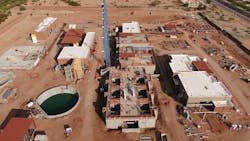Signal Butte Water Treatment Plant
Cost: $126 million
Location: Mesa, Ariz.
Year: 2018-12-01
Size: 16,667 gpm
Owner: City of Mesa
Designers: Black & Veatch
Contractor: Sundt Construction
The city of Mesa, Ariz., has a goal to meet 90% of its water demand through renewable surface water. The southeast part of the city was being served by groundwater and water pumped from the Brown Road Water Treatment Plant. As development in the southeast began to increase, the city’s Water Master Plan identified that a surface water treatment plant was needed to meet the goal of a sustainable water supply. The new Signal Butte Water Treatment Plant allows the city to utilize Colorado River water delivered through the Central Arizona Project (CAP) canal and conserve groundwater.
“At the beginning of the project, the engineer, contractor and the city met to create a mission statement for the project that laid out the project objective. It stated, ‘We are committed to serve the city of Mesa citizens by delivering a quality, cost-effective drinking water treatment plant that meets or exceeds customer expectations and that serves as a foundation for future economic vitality.’ The completion of the new Signal Butte Water Treatment Plant has allowed the city to continue to grow and support future economic development,” said Jesse Heywood, supervising engineer for the city of Mesa.
Mesa had a goal of meeting and exceeding the requirements of the existing national primary drinking water regulations, specifically the Stage 2 Disinfectants/Disinfection Byproducts Rule.
The Signal Butte Water Treatment Plant was designed with ozone generators and deep-bed biologically active granular activated carbon filler, which remove total organic carbon to reduce disinfectant byproducts. This allows the city to meet the goal of having disinfectant byproduct total trihalomethanes below 80% of the local running annual average requirement.
“The new water treatment plant utilizes ozone for the water oxidizer, sand ballasted flocculation for sedimentation and granular activated carbon for the filters,” Heywood said. “Onsite generated sodium hypochlorite is used as the main disinfectant. These state-of-the-art systems allow the water quality being produced to exceed the water quality standards set for the project.”
The city also has a goal of maintaining a safe site. Mesa installed state-of-the-art technology to generate a “bleach” solution on site for chlorination to reduce hazardous chemicals at the plant.
The compressed schedule was the biggest challenge. The project was delivered through the construction management at risk process.
“On a large project, there are several obstacles that must be overcome. The biggest was probably the schedule. The last six months of the schedule were very compressed,” Heywood said. “The water treatment plant has a number of vendor-supplied packages that have to be integrated to function as an overall treatment plant. Each vendor supplied their own programmable logic controller (PLC) that had to be integrated into the overall plant PLC.”
According to Heywood, the original start-up plan had a seven-day plant test where pumps would be set up and water would be pumped in a circle. This would have allowed the instrumentation and control integrator to be able to test the automation and programming of each system as the whole plant was operating. Unfortunately, there was not enough time in the schedule to be able to do that.
Each vendor-supplied system was started up with no overall coordinated testing. The systems integrator had to do a lot of programming testing in a simulator offline to vet out the programming and worked closely with the vendors to ensure that their programming was set up properly. After all the systems were installed, the programming was installed and the plant was started up. Fortunately, the preparation from the programmers paid off—the plant was started up with very few programming issues.
“This project had approximately 20,000 cu yards of concrete that had to be placed. The concrete work took 18 months of the 24-month construction schedule,” Heywood said. “At the time there was a shortage of skilled concrete workers to be able to complete the work due to some other high-profile projects in the greater Phoenix metro area.”
Coordination with other projects was another issue. The Signal Butte Water Treatment Plant is fed from the CAP Canal 3 miles to the east. A 54-in. raw water line had to be constructed to bring water to the plant. The timing had to coincide with plant construction.
Sundt Construction had to come up with some creative ways to recruit and retain the necessary workers. They offered signing bonuses for new concrete workers and instituted a bonus system. At the peak of concrete construction there were 10 concrete crews. If each crew completed its assigned tasks for that week and had no safety issues, it would be entered into a weekly drawing for a $1,000 bonus to be shared amongst the crew. This helped Sundt to keep crews focused on meeting milestones and staying engaged.
Project Year: 2018-12-01Contractor: Sundt ConstructionDesigners: Black & VeatchOwner: City of MesaLocation: Mesa, Ariz.Cost: $126 millionSize: 16,667 gpm